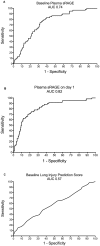Receptor for advanced glycation end-products and ARDS prediction: a multicentre observational study
- PMID: 29422518
- PMCID: PMC5805783
- DOI: 10.1038/s41598-018-20994-x
Receptor for advanced glycation end-products and ARDS prediction: a multicentre observational study
Abstract
Acute respiratory distress syndrome (ARDS) prediction remains challenging despite available clinical scores. To assess soluble receptor for advanced glycation end-products (sRAGE), a marker of lung epithelial injury, as a predictor of ARDS in a high-risk population, adult patients with at least one ARDS risk factor upon admission to participating intensive care units (ICUs) were enrolled in a multicentre, prospective study between June 2014 and January 2015. Plasma sRAGE and endogenous secretory RAGE (esRAGE) were measured at baseline (ICU admission) and 24 hours later (day one). Four AGER candidate single nucleotide polymorphisms (SNPs) were also assayed because of previous reports of functionality (rs1800625, rs1800624, rs3134940, and rs2070600). The primary outcome was ARDS development within seven days. Of 500 patients enrolled, 464 patients were analysed, and 59 developed ARDS by day seven. Higher baseline and day one plasma sRAGE, but not esRAGE, were independently associated with increased ARDS risk. AGER SNP rs2070600 (Ser/Ser) was associated with increased ARDS risk and higher plasma sRAGE in this cohort, although confirmatory studies are needed to assess the role of AGER SNPs in ARDS prediction. These findings suggest that among at-risk ICU patients, higher plasma sRAGE may identify those who are more likely to develop ARDS.
Conflict of interest statement
The authors declare no competing interests.
Figures




References
-
- ARDS Definition TF, et al. Acute respiratory distress syndrome: the Berlin Definition. JAMA. 2012;307:2526–2533. - PubMed
-
- Neto AS, et al. Epidemiological characteristics, practice of ventilation, and clinical outcome in patients at risk of acute respiratory distress syndrome in intensive care units from 16 countries (PRoVENT): an international, multicentre, prospective study. Lancet Respir Med. 2016;4:882–893. doi: 10.1016/S2213-2600(16)30305-8. - DOI - PubMed
-
- Yadav, H., Thompson, B. T. & Gajic, O. Fifty Years of Research in ARDS. Is Acute Respiratory Distress Syndrome a Preventable Disease? Am. J. Respir. Crit. Care Med. 10.1164/rccm.201609-1767CI (2016) - PubMed
-
- Pham, T. & Rubenfeld, G. D. Fifty Years of Research in ARDS. The Epidemiology of ARDS: A Fiftieth Birthday Review. Am. J. Respir. Crit. Care Med. 10.1164/rccm.201609-1773CP (2017). - PubMed
Publication types
MeSH terms
Substances
LinkOut - more resources
Full Text Sources
Other Literature Sources

